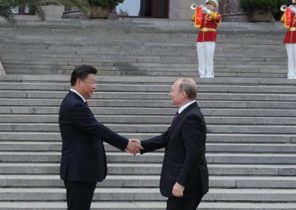1 June commander of the Northern fleet of Russia announced that in the near future, the Navy will send more than 30 ships and 20 fighters to conduct large-scale exercises in the Barents and Norwegian seas. Earlier, naval forces of the United States and other NATO countries included in the Barents sea under the pretext of “free shipping”.
In fact, the recent actions of the United States and Russia in the Arctic region attract public attention.
In late April, the United States transferred to the airbase “Alison” in Alaska two fifth generation fighter F-35A. According to the plan, by the end of 2021, the us military deployed here 54 combat aircraft F-35A. Earlier on base military-air forces of the USA “joint base Elmendorf”, located in Alaska, arrived two squadrons of F-22. In the near future Alaska, which borders Russia across the sea, will be home to the greatest concentration of new stealth fighters of the U.S. air force.
Similarly at the end of April, the Russian airborne troops made a landing from a height of 10 thousand meters in the archipelago of Franz Josef. In this regard, the defense Ministry said that “for the first time in history, we held a panel landing personnel parachute systems for special purposes in Arctic conditions with a height of 10 thousand meter”. It is reported that similar exercises in the future will be held annually in different parts of the Arctic.
The above steps demonstrate that the competition between the United States and Russia in the Arctic region is becoming increasingly fierce. It is obvious that the growing rivalry between the armed forces of the two countries.
Currently, Russia is in the Arctic circle deployed a lot of military aircraft of various types, the best of which is the fighter-interceptor MiG-31, which is called “Fox hound”. The aircraft can carry missiles and perform several tasks as anti-aircraft and missile defense, and to hit low-orbit satellites and enemy aircraft carriers. It is a powerful force to escort Russian strategic bombers in the Arctic region. The MiG-31 was tested repeatedly in joint combat operations with various types of aircraft and made a successful shot hypersonic missiles “Dagger” in Arctic conditions.
In addition, from August 2019 to April 2020 anti-aircraft missile regiment of the aerospace forces of the Russian Federation, stationed in the Arctic, adopted a large batch of modified anti-aircraft missile systems s-300 and s-400, and actively held joint exercises with fighter jets. According to the us military, increasing military potential of the Russian Air and space forces in the Arctic region poses a serious challenge to their air force. Thus, the placement of the advanced fighters is a countermeasure of the United States in response to Russia’s actions to strengthen air defense system.
The confrontation between the US and Russia in the Arctic is limited not only by the endless expanse of the sky.
In March 2020, the United States began to hold biennial joint military exercises “ICEX-2020” (“Ice exercise”) in the Arctic zone, in which also participated the United Kingdom, Canada, Norway and Japan. Unfortunately for the American military, nuclear submarine “Seawolf” (“Sea wolf”) under the name “Connecticut” stuck in the ice during the course of the scenario the missile strikes. This is not the first such incident the Americans in the Arctic. During exercise ICEX-2018 nuclear submarine “Hartford” also had to rescue from the ice prison with the help of saws.
Against this, the chief of the Russian Navy said that all the nuclear submarines of Northern and Pacific fleet unable to break the ice and float to the surface in the Arctic, while the United States can do only a limited number of submarines. In recent years, Russia is continuously strengthening its military potential in the Arctic region, in order to protect their interests. As noted by the Russian defense Minister Sergei Shoigu, “one of the priority activities of the Ministry of defense is developing in this area of military infrastructure.” According to reports, by the end of this year, the Northern fleet will have to adopt four new ships, and more than 180 pieces of weapons and military equipment, which is adapted for use in the harsh conditions of the Arctic.
Appeared access to the Northern sea route revealed the strategic importance of this region. Despite the strategic pressure from the United States and its allies, Russia is not going to give up and through their geographical advantages trying to fight for the leading positions in the Arctic region. At the same time, among other countries around the Arctic are also growing competition for cooperation with the United States and Russia. Thus, on the chessboard in the Arctic can appear new figures. It is obvious that in the future this region will become the center of attention of all parties.







